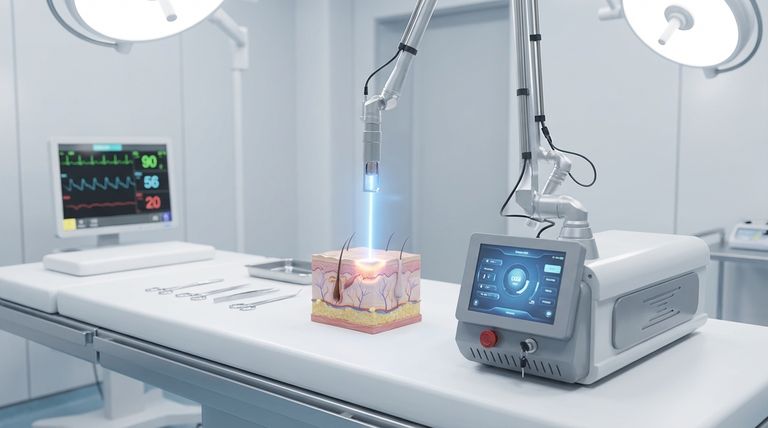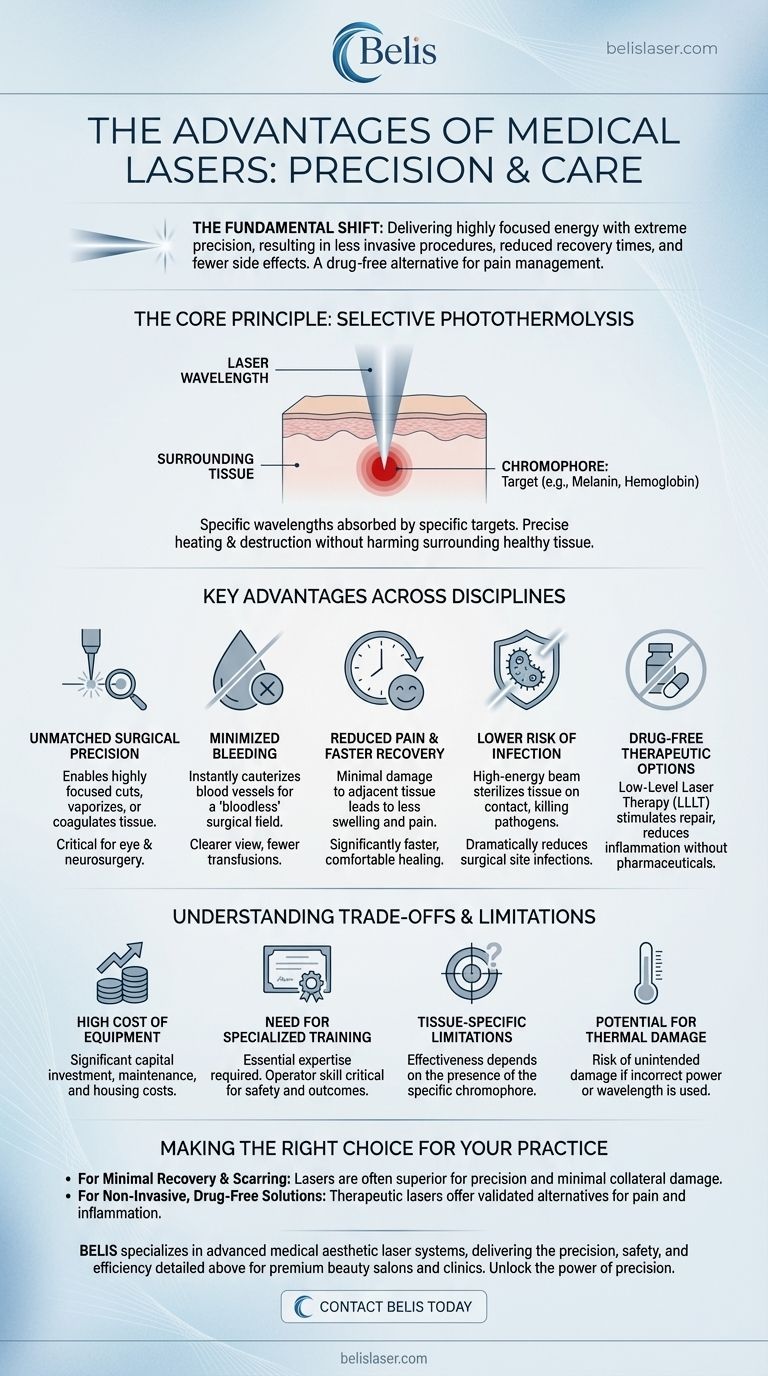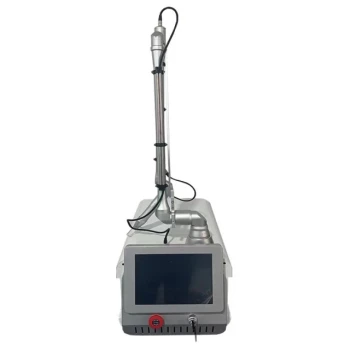The fundamental advantages of lasers in medicine stem from their ability to deliver highly focused energy with extreme precision, resulting in less invasive procedures, reduced recovery times, and fewer side effects. This precision allows clinicians to target specific tissues, like a tumor or a hair follicle, while leaving surrounding healthy tissue unharmed. For therapeutic applications, lasers can offer a drug-free alternative for managing pain and inflammation, avoiding the risks associated with medications like opioids.
The core value of a medical laser is not just that it's a "light scalpel," but its unique ability to interact with specific biological tissues selectively. This principle, known as selective photothermolysis, is the foundation for nearly all its advantages, from bloodless surgery to scar-free skin treatments.

The Core Principle: How Lasers Achieve Precision
The magic of medical lasers lies in a concept called selective photothermolysis. Understanding this single principle is key to understanding why they are so effective.
What is Selective Photothermolysis?
This process is based on a simple idea: specific wavelengths of light are absorbed by specific targets in the body, known as chromophores. The primary chromophores are water, hemoglobin (in blood), and melanin (in skin and hair).
By choosing a laser with a specific wavelength, a clinician can precisely heat and destroy a target containing a matching chromophore, without significantly heating the surrounding tissue.
The Impact on Medical Procedures
Imagine wanting to remove a small, pigmented lesion on the skin. A laser tuned to target melanin will be absorbed by the lesion, destroying it with heat. The surrounding skin, having less melanin, remains cool and undamaged.
This is fundamentally different from a scalpel, which cuts all tissue in its path, or general cautery, which burns indiscriminately.
Key Advantages Across Medical Disciplines
This principle of selective energy delivery creates a cascade of benefits that have revolutionized fields from surgery to dermatology.
Unmatched Surgical Precision
A laser beam can be focused to a tiny spot, allowing surgeons to cut, vaporize, or coagulate tissue with a level of precision that is impossible with a physical scalpel. This is critical in delicate procedures like eye surgery (LASIK) and neurosurgery.
Minimized Bleeding
As the laser cuts, its intense heat instantly cauterizes blood vessels. This results in a "bloodless" surgical field, giving the surgeon a clearer view and reducing the need for transfusions.
Reduced Pain and Faster Recovery
Because lasers cause minimal damage to adjacent healthy tissue, patients typically experience less post-operative swelling, inflammation, and pain. This often translates to a significantly faster and more comfortable recovery.
Lower Risk of Infection
The high-energy laser beam effectively sterilizes the tissue it touches, killing bacteria and other pathogens on contact. This dramatically reduces the risk of surgical site infections compared to traditional incisions.
Drug-Free Therapeutic Options
Low-Level Laser Therapy (LLLT), or photobiomodulation, uses low-intensity light to stimulate cellular repair and reduce inflammation. It is a powerful, drug-free method for managing chronic pain, healing wounds, and reducing swelling, avoiding the costs and side effects of pharmaceuticals.
Understanding the Trade-offs and Limitations
While powerful, laser technology is not a universal solution. Its application requires careful consideration of its downsides.
High Cost of Equipment
Medical laser systems are a significant capital investment. The cost of purchasing, maintaining, and housing this sophisticated equipment can make laser treatments more expensive than traditional alternatives.
The Need for Specialized Training
Operating a medical laser safely and effectively requires extensive training and expertise. In the wrong hands, a laser can cause severe burns, scarring, or incomplete treatment. Operator skill is a critical factor in patient outcomes.
Tissue-Specific Limitations
The effectiveness of a laser is entirely dependent on the presence of its target chromophore. A laser designed to target melanin in hair follicles will be ineffective for removing blonde hair, which lacks sufficient melanin.
Potential for Thermal Damage
Even with precise targeting, there is always a risk of unintended thermal damage if the wrong power settings or wavelength are used. Strict safety protocols are essential to protect both the patient and the clinical staff from accidental exposure.
Making the Right Choice for Your Goal
The decision to use a laser depends entirely on the specific medical objective and the patient's priorities.
- If your primary focus is minimizing recovery time and scarring: Lasers are often the superior choice for procedures where precision and minimal collateral damage are critical.
- If your primary focus is a non-invasive, drug-free solution: Therapeutic lasers offer a validated alternative for managing chronic pain and inflammation without the risks of medication.
- If your primary focus is broad accessibility and lower cost: Traditional surgical methods remain the standard of care for many procedures and are often more widely available and affordable.
Ultimately, understanding the laser as a tool for focused energy delivery empowers you to see its clear and transformative role in modern medicine.
Summary Table:
| Advantage | Key Benefit |
|---|---|
| Surgical Precision | Enables highly focused cuts with minimal damage to surrounding tissue. |
| Minimized Bleeding | Cauterizes blood vessels instantly for a bloodless surgical field. |
| Faster Recovery | Reduces post-operative pain and swelling for quicker healing. |
| Lower Infection Risk | Sterilizes tissue on contact to minimize surgical site infections. |
| Drug-Free Therapy | Offers alternatives like LLLT for pain and inflammation without medication. |
Unlock the Power of Precision for Your Practice
BELIS specializes in professional medical aesthetic equipment, serving medical aesthetics clinics and premium beauty salons. Our advanced laser systems deliver the precision, safety, and efficiency detailed above, helping you offer cutting-edge treatments with superior patient outcomes. Whether you're expanding your service portfolio or upgrading your technology, our experts are here to guide you.
Contact BELIS today to explore how our medical lasers can transform your practice.
Visual Guide

Related Products
- Fractional CO2 Laser Machine for Skin Treatment
- Fractional CO2 Laser Machine for Skin Treatment
- Pico Picosecond Laser Machine for Tattoo Removal Picosure Pico Laser
- Diode Laser SHR Trilaser Hair Removal Machine for Clinic Use
- EMSlim RG Laser Body Sculpting and Slimming Machine
People Also Ask
- What will my face look like after a CO2 laser? Your Complete Recovery Timeline
- What does a CO2 laser do to your face? Achieve Profound Skin Resurfacing & Renewal
- How long after a CO2 laser will I see results on my face? A Timeline for Transformation
- What is a fractional CO2 laser machine used for? A Guide to Advanced Skin Resurfacing
- What are medical lasers used for? Precision Tools for Surgery and Skin Treatments



















